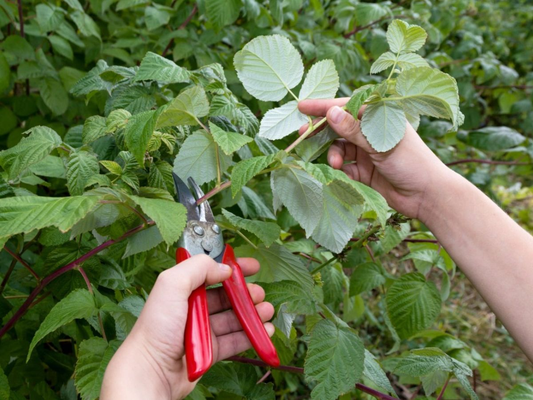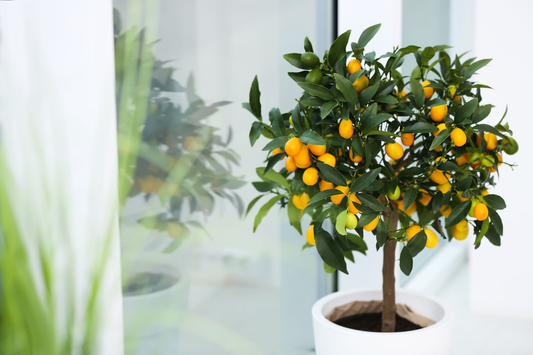Fresh, Flavorful, and Convenient: How to Grow Herbs on a Windowsill for Busy Cooks!
Share
Table of Contents
1. Introduction: The Appeal of Growing Herbs on a Windowsill
Growing herbs on a windowsill is not just a trend—it's a practical and rewarding way to enjoy fresh, flavorful herbs right in the comfort of your own home. Whether you're an experienced gardener or a beginner, windowsill herb gardening offers numerous benefits that make it a perfect choice for busy individuals looking to elevate their cooking and lifestyle.
Here are some of the key benefits of growing herbs on your windowsill:
-
Convenience of Fresh Herbs Year-Round:
- With a windowsill herb garden, you'll have easy access to fresh herbs right at your fingertips.
- Having them close by saves you time and energy, especially during busy cooking moments.
-
Space-Saving and Ideal for Small Environments:
- Herbs are well-suited to small spaces, making them perfect for apartments, condos, or homes without large gardens.
- Windowsills offer an ideal spot for plants, utilizing natural light while taking up minimal space.
-
Enhanced Cooking Experience:
- Fresh herbs can significantly enhance the flavor and quality of your dishes.
- Cooking with fresh herbs brings out vibrant flavors and adds a sense of freshness to every meal.
-
Growing Popularity Among Busy Individuals:
- Windowsill gardening has gained immense popularity, especially among people who are looking for convenient and sustainable ways to grow food.
- For busy individuals, it's a low-maintenance solution that fits well into hectic schedules without requiring extensive gardening knowledge or time.
More and more people are realizing the value of a windowsill garden—not just for aesthetics, but for providing fresh ingredients without the need for a backyard or garden space. It's a small, sustainable way to incorporate nature into your home while enhancing your cooking experience.

2. Why Growing Herbs on a Windowsill is Perfect for Busy Cooks
For busy cooks, a windowsill herb garden is a game-changer. The convenience of having fresh herbs within arm's reach while preparing meals is not only a time-saver but also a great way to enhance your culinary creations. Here’s why growing herbs on a windowsill is perfect for those with tight schedules:
-
Convenience of Fresh Herbs on Hand:
- Imagine cooking your favorite dish and having fresh basil, thyme, or rosemary right on your windowsill—no need to run to the store.
- Herbs like mint, parsley, and cilantro are perfect for last-minute additions, giving your meals an immediate flavor boost.
-
Saving Time and Money:
- Instead of buying fresh herbs that might wilt before you can use them, growing your own ensures you have a steady supply of fresh herbs without the waste.
- By cultivating herbs on your windowsill, you can save money over time, as you no longer need to buy fresh herbs for every meal.
-
Elevating Everyday Meals and Snacks:
- Fresh herbs can elevate the simplest dishes, adding depth and complexity to your meals with minimal effort.
- Whether it's a sprinkle of fresh oregano on pasta, a handful of basil in your salad, or a dash of thyme in your soup, herbs bring vibrant flavor to everyday meals.
-
Part of the Growing Trend of Sustainable and Home-Based Food Practices:
- Growing your own herbs at home is part of a larger movement toward sustainability and reducing food waste.
- With more people seeking to reduce their carbon footprint, cultivating herbs at home is a simple and effective way to support eco-friendly practices while improving your meals.
3. Choosing the Right Herbs for Your Windowsill Garden
Choosing the right herbs for your windowsill garden is essential to ensure they thrive indoors. While many herbs can adapt to indoor environments, some varieties are better suited to small spaces and low-light conditions than others. Here are some herbs that thrive indoors:
-
Herbs That Thrive Indoors:
- Basil: A popular herb with a sweet and peppery flavor. It requires plenty of sunlight and regular pruning.
- Mint: Known for its fresh and cool flavor. Mint grows well in partial sunlight and is easy to maintain, but it can be invasive.
- Parsley: Earthy and fresh, parsley thrives with moderate sunlight and regular watering.
- Thyme: A hardy herb with a savory flavor, thyme prefers full sun and moderate watering.
- Rosemary: This woody, aromatic herb grows well in full sun and is low maintenance once established.
- Chives: Mild and onion-flavored, chives require minimal care and grow well in bright, indirect sunlight.
- Oregano: A savory herb that thrives in full sun and is very easy to grow indoors.
- Cilantro: Known for its bright, citrusy flavor, cilantro needs regular watering and moderate sun.
-
Factors to Consider When Choosing Herbs:
- Light: Herbs need access to natural light, so consider the amount of sunlight your windowsill receives. Most herbs need at least 4-6 hours of direct sunlight per day.
- Space: Make sure your windowsill has enough space for the herbs to grow. Some herbs, like mint, can spread quickly, while others, like basil, may need regular pruning to stay manageable.
- Temperature: Ideal temperatures for most indoor herbs range between 60-75°F (15-24°C). Ensure your indoor environment stays within this range for healthy growth.
-
Suggested Hardy Herbs for Beginners:
- Mint and Chives are excellent beginner-friendly herbs due to their low-maintenance needs.
- Rosemary and Oregano are also easy to care for and can tolerate a variety of indoor conditions.
To make it easier to choose the right herbs, here's a table summarizing the key factors for beginners:
| Herb | Light Requirements | Temperature Range | Size and Maintenance | Flavor Profile |
|---|---|---|---|---|
| Basil | Full sun (6+ hours/day) | 60–75°F (15-24°C) | Regular pruning | Sweet, peppery |
| Mint | Partial sun | 60–75°F (15-24°C) | Minimal care, invasive | Fresh, cool |
| Rosemary | Full sun | 65–80°F (18-27°C) | Low maintenance | Woody, aromatic |
| Parsley | Moderate sun | 60–75°F (15-24°C) | Regular watering | Earthy, fresh |
These herbs are not only easy to grow but also offer a wide variety of flavors for your cooking needs. Consider your space, light availability, and the time you can dedicate to care when choosing which herbs to grow on your windowsill.
4. How to Set Up Your Windowsill Herb Garden
Setting up your windowsill herb garden is an exciting process, but it requires careful planning to ensure your herbs thrive. Here’s a step-by-step guide to help you create a productive and beautiful indoor garden:
-
Choosing the Right Container:
- Small Pots: Small individual pots are great for herbs like basil, mint, and thyme. They provide enough space for roots to spread and make it easier to move plants around as needed.
- Window Boxes: A window box can accommodate multiple herbs at once. It’s an efficient use of space and allows you to grow several varieties together.
- Containers with Drainage Holes: Ensure your containers have drainage holes to prevent water from accumulating in the soil. This helps prevent root rot and encourages healthy plant growth.
-
Selecting the Ideal Windowsill:
-
Sunlight Requirements:
- East-facing windows: These windows receive soft, indirect morning light, which is perfect for herbs like parsley and cilantro.
- South-facing windows: These windows provide the most sunlight throughout the day, making them ideal for sun-loving herbs like basil and rosemary.
- West-facing windows: West-facing windows get strong afternoon sun, which is great for herbs like thyme and oregano.
-
Adjusting for Temperature and Humidity:
- Herbs generally prefer temperatures between 60–75°F (15–24°C). Be mindful of drafts from windows that might cause the temperature to fluctuate.
- If your home is dry, consider adding a small humidity tray or using a humidifier to maintain the ideal environment for your plants.
-
Sunlight Requirements:
-
Soil and Drainage:
- Importance of Well-Draining Soil: Herbs need well-draining soil to prevent waterlogging. Using soil with good drainage helps prevent root rot and promotes strong, healthy growth.
- Right Potting Mix: A general-purpose potting mix is often fine for most herbs, but you can also use a mix designed specifically for herbs, which tends to be lighter and well-aerated.
-
Recommended Soil Mixes:
- Cactus or Succulent Mix: This is great for herbs like rosemary and thyme that prefer well-draining soil.
- Organic Potting Mix: Ideal for a variety of herbs, offering balanced nutrients and good aeration.
- Peat-based Mix: Suitable for moisture-loving herbs like parsley and cilantro.
-
Spacing and Arrangement:
- When arranging your herbs on the windowsill, keep in mind their sunlight requirements. Place sun-loving herbs (like basil and rosemary) where they’ll receive the most direct light, and shade-tolerant herbs (like mint and parsley) in less sunny spots.
- Make sure to leave enough space between each pot to allow for proper airflow, which helps prevent fungal growth and keeps the plants healthy.

5. Planting and Caring for Your Herb Garden
Once you’ve set up your windowsill garden, it’s time to plant and care for your herbs. Proper planting and maintenance ensure your plants thrive and provide fresh ingredients for your meals. Here’s a step-by-step guide:
-
Planting:
-
Step-by-Step Process for Planting Herbs from Seeds or Small Starter Plants:
- If starting from seeds, fill your container with well-draining soil, leaving a small gap at the top.
- Lightly press seeds into the soil, covering them with a thin layer of soil (depending on seed size, typically no more than 1/4 inch deep).
- For starter plants, gently remove the plant from its original container, and place it into a new pot with enough space for roots to spread.
- Ensure that the root ball is level with the surface of the soil, and press the soil around the plant gently to secure it.
-
Depth, Spacing, and Watering Guidelines:
- Plant seeds according to the packet instructions (most herbs like basil, mint, and parsley require shallow planting).
- Space starter plants about 6–8 inches apart to allow room for growth. Smaller herbs like chives and oregano can be placed closer together.
- Water immediately after planting to help settle the soil. Ensure that the soil is moist, not soggy, to promote seed germination and plant establishment.
-
Step-by-Step Process for Planting Herbs from Seeds or Small Starter Plants:
-
Watering and Fertilization:
-
How Often to Water Herbs:
- Water your herbs when the top 1-2 inches of soil feels dry. Herbs like basil and rosemary prefer their soil to dry out a bit between watering, while cilantro and mint like more consistent moisture.
- Ensure good drainage to prevent overwatering, which can cause root rot. If you notice the leaves turning yellow or brown, this could indicate overwatering.
-
Signs of Overwatering:
- Yellowing or wilting leaves can indicate that the plant is sitting in waterlogged soil. Check the drainage and reduce watering frequency.
- Root rot may occur if the roots remain soaked for too long. If the roots appear dark and mushy, it’s time to replant in fresh, well-draining soil.
-
Fertilization Tips for Herbs Grown Indoors:
- Feed your herbs with a balanced, water-soluble fertilizer once a month during the growing season (spring to summer).
- Use a diluted fertilizer to avoid overfeeding, as too much can lead to leggy plants or reduced flavor.
- Consider organic options like fish emulsion or seaweed-based fertilizers for a natural, slow-release nutrient source.
-
How Often to Water Herbs:
-
Pruning and Harvesting:
-
Proper Ways to Trim and Harvest Herbs Without Damaging Them:
- Harvest leaves by pinching or cutting just above a leaf node to encourage new growth. Avoid cutting too much from a single stem to ensure the plant doesn’t become stressed.
- For herbs like mint and basil, regularly pinch off flowers as they appear to maintain the plant’s energy for leaf production.
-
The Importance of Regular Pruning for Healthy Growth:
- Pruning helps prevent plants from becoming leggy (too tall and thin) and encourages bushier, more productive growth.
- Remove dead or yellowing leaves to prevent disease and improve airflow around the plant.
-
Proper Ways to Trim and Harvest Herbs Without Damaging Them:
-
Dealing with Common Issues (Yellowing Leaves, Leggy Plants, etc.):
- Yellowing Leaves: Often caused by overwatering, nutrient deficiencies, or pests. Check watering habits and ensure the plant is getting enough light.
- Leggy Plants: This occurs when a plant isn’t getting enough light. Try moving your herb closer to a window with more sunlight or supplementing with a grow light.
- Pests and Diseases: Look out for common indoor pests like aphids or spider mites. Use an insecticidal soap or rinse plants with water to remove pests. If mildew or mold appears, remove affected leaves and adjust humidity levels.

6. Maximizing Space and Light in Small Areas
Even in small living spaces, it’s possible to create a thriving windowsill herb garden. With a little creativity, you can maximize space and light to give your herbs the best chance to grow. Here are some practical ways to do it:
-
Creative Container Options:
-
Using Hanging Planters:
- Hang planters from the ceiling or a window hook to keep herbs off countertops while still getting sunlight.
- Choose lightweight containers to make it easy to adjust the height of the planters.
-
Using Shelves or Vertical Racks:
- Install floating shelves on your windowsill or nearby wall to create extra space for small pots.
- Vertical racks allow you to stack multiple levels of herbs, giving each plant ample light without overcrowding the space.
-
Using Hanging Planters:
-
Grow Lights:
-
How to Use Grow Lights to Enhance Sunlight:
- If your windowsill doesn’t receive enough natural light, supplement with grow lights to boost plant growth.
- Place the lights about 12–18 inches above the plants for optimal light distribution.
-
LED vs. Fluorescent Grow Lights:
- LED Grow Lights: More energy-efficient, longer-lasting, and emit less heat. Great for small spaces and cost-effective in the long run.
- Fluorescent Grow Lights: A budget-friendly option that works well for herbs, but they may need to be replaced more frequently than LEDs.
-
How to Use Grow Lights to Enhance Sunlight:
-
Space-Saving Techniques:
-
Rotating Plants for Even Sunlight Exposure:
- Rotate your plants every few days to ensure all sides receive equal sunlight exposure, promoting even growth.
- This also helps prevent plants from becoming leggy as they stretch toward light.
-
Compact Planters and Multitiered Systems:
- Use compact, shallow planters for herbs that don’t require deep roots, allowing more plants to fit in small spaces.
- Consider multitiered systems or stackable containers to save horizontal space while giving each plant room to grow vertically.
-
Rotating Plants for Even Sunlight Exposure:
7. Common Challenges of Growing Herbs on a Windowsill and How to Overcome Them
Growing herbs indoors on a windowsill can be rewarding, but there are common challenges you might face. Fortunately, most of these issues can be easily addressed with a little attention and care. Here's how to overcome some of the most frequent challenges of windowsill herb gardening:
-
Lack of Sunlight:
-
Solution 1: Rotate Your Plants:
- Ensure each herb gets an equal amount of sunlight by rotating pots regularly.
- Turning your plants every few days can help prevent them from becoming leggy or leaning toward the light source.
-
Solution 2: Use Supplemental Grow Lights:
- If your windowsill doesn’t receive enough natural light, supplement it with grow lights. LED or fluorescent grow lights are great for boosting light intensity.
- Place grow lights 12–18 inches above your herbs for optimal growth, especially during cloudy days or the winter months.
-
Solution 1: Rotate Your Plants:
-
Pests and Diseases:
-
Common Indoor Pests:
- Aphids: Small insects that can be removed by gently spraying the leaves with a mixture of water and soap or neem oil.
- Spider Mites: These tiny pests can be controlled by wiping down the leaves with a damp cloth or applying neem oil regularly.
-
Natural Remedies:
- Neem Oil: A natural pesticide that can help control pests without harming the plants.
- Water Sprays: Sometimes a gentle spray of water can help dislodge pests from leaves and stems.
-
Preventing Fungal Diseases:
- Indoor plants are more susceptible to fungal diseases due to humidity. To prevent them, ensure proper airflow around your plants.
- Avoid overwatering, as damp soil can promote mold and mildew growth. Ensure pots have drainage holes to prevent stagnant water.
-
Common Indoor Pests:
-
Temperature Fluctuations:
-
Drafts and Temperature Shifts:
- Avoid placing your herb garden near drafts or sources of extreme heat (such as radiators or heaters), as rapid temperature changes can harm your plants.
- If your windowsill gets too cold, especially in winter, consider moving your plants away from the window at night and returning them during the day.
-
Protecting from Sudden Cold or Heat:
- Use window coverings like sheer curtains or blinds to moderate extreme heat or cold from the windowpane.
- If the temperature fluctuates dramatically, place a barrier (like a towel) between the window and your plants to buffer the effects.
-
Drafts and Temperature Shifts:

8. Harvesting and Using Your Fresh Herbs in Cooking
Harvesting and using your own fresh herbs can take your cooking to the next level. Growing herbs on your windowsill not only provides you with fresh ingredients but also offers a satisfying and rewarding experience. Here's how to make the most of your harvest:
-
Best Time to Harvest Herbs:
-
When to Start Harvesting:
- For most herbs, wait until the plant is well-established and has several sets of leaves before beginning to harvest. This ensures the plant is strong enough to continue growing.
- It’s best to harvest herbs early in the morning after the dew has evaporated but before the sun is too hot, as this is when the essential oils are at their peak.
-
How Much to Take:
- Only take a third of the plant at any given time to ensure it has enough leaves to keep growing. This helps maintain the plant's overall health.
- Use clean, sharp scissors or pruning shears to avoid damaging the plant and ensure clean cuts.
-
When to Start Harvesting:
-
Tips for Storing Harvested Herbs:
-
Drying:
- For herbs like oregano, thyme, and rosemary, drying is an excellent option. Simply hang small bundles upside down in a dry, dark place for a few weeks.
- Once dry, remove the leaves from the stems and store them in airtight containers away from direct sunlight.
-
Freezing:
- Herbs such as basil, cilantro, and parsley freeze well. Chop the herbs and place them in an ice cube tray with water or olive oil for easy use later on.
- Alternatively, place whole leaves on a baking sheet in a single layer, freeze them, and then transfer to a freezer-safe bag.
-
Refrigerating:
- For short-term storage, place fresh herbs like parsley, cilantro, and basil in a jar with a small amount of water and cover with a plastic bag. Store them in the fridge.
- Alternatively, wrap herbs in a damp paper towel and place them in a sealed plastic bag to keep them fresh for a few days.
-
Drying:
-
How Fresh Herbs Elevate Meals:
- Pesto: Fresh basil, garlic, pine nuts, olive oil, and Parmesan cheese come together to create a vibrant, aromatic pesto that can be added to pasta, sandwiches, and salads.
- Salads: Add fresh parsley, mint, or cilantro to salads for a burst of flavor and a fresh, herbal touch.
- Soups: Herbs like thyme, rosemary, and basil can enhance the flavor of soups and stews. Add them at the start of cooking for an infused taste or sprinkle fresh herbs at the end for a burst of freshness.
- Herbal Teas: Fresh mint, chamomile, or lemon balm can be used to make soothing teas that are both fragrant and refreshing.
-
Ideas for Using Herbs in Daily Cooking:
- Garnish: Fresh herbs make the perfect garnish for almost any dish. Sprinkle chopped cilantro, parsley, or basil on top of soups, pasta, or roasted vegetables to enhance both the flavor and the presentation.
- Infusions: Fresh herbs can be infused into oils or vinegars for a homemade, aromatic ingredient to use in dressings and marinades.
- Flavor Bases: Use herbs like rosemary, thyme, or sage to build flavor bases for your meals. These herbs can be sautéed with onions and garlic to start many dishes, from stir-fries to braises.
9. Sustainable Herb Gardening on Your Windowsill
Growing herbs on your windowsill isn't just a convenient way to have fresh ingredients at hand—it’s also an eco-friendly practice that supports sustainability and reduces food waste. Here's how windowsill herb gardening can contribute to a more sustainable lifestyle:
-
Benefits of Growing Herbs at Home in Reducing Food Waste:
- By growing your own herbs, you can avoid the waste that often comes with buying fresh herbs from the store, where excess can spoil before it’s used.
- Growing just the right amount of herbs means you can harvest exactly what you need, reducing the likelihood of unused herbs going to waste.
-
How to Compost Herbs and Other Kitchen Waste for Organic Gardening:
- Composting is a great way to reduce food waste and nourish your herb garden. Organic kitchen scraps such as vegetable peels, coffee grounds, and herb stems can be composted.
- Ensure you have a balanced compost mix of greens (nitrogen-rich materials) and browns (carbon-rich materials) for optimal decomposition.
- Compost not only reduces landfill waste but also creates nutrient-rich soil that can be used to fertilize your herb garden, closing the loop in your sustainable gardening practices.
-
Promoting Sustainability by Growing Herbs Rather Than Purchasing Them:
- By growing herbs at home, you eliminate the need for packaging and transportation associated with store-bought herbs, further reducing your environmental impact.
- Herbs grown at home are free from pesticides and other harmful chemicals, making them a healthier choice for you and the planet.
- Additionally, homegrown herbs allow you to control the amount of water and energy used, making your herb garden even more eco-conscious.

10. Conclusion: Embrace the Joy of Fresh Herbs on Your Windowsill
Growing herbs on your windowsill is not just about adding a touch of greenery to your kitchen—it's about embracing convenience, sustainability, and flavor. For busy cooks, having fresh herbs at your fingertips can transform your meals with minimal effort. Whether it's the sweet, peppery taste of basil or the aromatic appeal of rosemary, herbs can elevate everyday dishes and make cooking an enjoyable, efficient experience.
Now is the perfect time to start your own windowsill herb garden. With just a few simple steps, you can grow a variety of herbs in the comfort of your home, no matter how small your space. From choosing the right herbs and containers to mastering the art of pruning and harvesting, you'll soon be reaping the rewards of your own homegrown herbs.
Ready to get started? At Xroci, we offer a wide selection of live herb plants that are perfect for windowsill gardening. Visit our shop for top-quality herb plants and gardening supplies, and begin your journey toward fresh, homegrown ingredients today!
11. FAQ - Frequently Asked Questions
Here are some frequently asked questions to help you navigate the ins and outs of growing herbs on a windowsill. Whether you're a beginner or experienced herb grower, these tips will ensure your plants thrive in their indoor garden.
-
Can I grow herbs on a north-facing windowsill?
A north-facing windowsill typically receives less direct sunlight, which may not be ideal for most herbs. However, some herbs like mint, parsley, and chives can tolerate less sunlight. To ensure healthy growth, consider using supplemental grow lights to provide the light your herbs need.
-
How do I know if my herbs are getting enough sunlight?
Herbs require 4–6 hours of direct sunlight a day. If your plants are becoming leggy (long stems with few leaves) or the leaves are turning yellow, it could be a sign that they are not getting enough light. Consider moving them to a sunnier location or using a grow light to supplement the natural light.
-
How often should I water my herbs on a windowsill?
Watering frequency depends on the type of herb and the environment, but generally, you should water your herbs when the top inch of soil feels dry. Overwatering can cause root rot, so ensure the pots have good drainage and avoid letting your herbs sit in water. A general rule is to water deeply but infrequently.
-
Can I grow all types of herbs indoors, or are some better suited for windowsills?
Not all herbs thrive indoors, but many popular varieties do well in windowsill gardens. Herbs like basil, mint, parsley, thyme, and rosemary adapt well to indoor growing conditions. However, herbs that require a lot of sunlight, like cilantro and dill, may struggle without direct light, so choose wisely based on your space.
-
How do I prevent pests from invading my indoor herb garden?
Common indoor pests include aphids, spider mites, and whiteflies. To prevent infestations, regularly inspect your plants for signs of pests. Natural remedies like neem oil or a mild soap spray can help keep pests at bay. Additionally, ensure proper airflow and avoid overwatering, which can attract pests.
-
What should I do if my herb plants are growing too tall or leggy?
If your herbs are growing tall and leggy, it could be a sign that they’re not getting enough light. You can trim the leggy growth and place them in a sunnier spot or use grow lights to encourage more compact growth. Regular pruning will also help your herbs grow more evenly and bushier.
-
Can I grow herbs in a windowsill garden during the winter?
Yes, many herbs can be grown year-round, even during the winter months. However, during colder months, your indoor plants may require extra attention. Ensure they are getting adequate light, and consider using grow lights if sunlight is limited. Keep an eye on the temperature, and avoid placing your plants near cold drafts.
-
How do I store fresh herbs for later use?
If you have an abundance of herbs, you can store them in various ways. Fresh herbs can be refrigerated in a damp paper towel and placed in a sealed container. You can also freeze herbs in ice cube trays with water or olive oil for easy use in future cooking. For long-term storage, consider drying herbs or using a dehydrator.
Additional Resources
How to Start an Indoor Vegetable Garden: The Surprising Benefits You D – XRoci
The Best Fruits for Small Gardens You Won't Believe Can Fit in Your Ba – XRoci
How to Propagate Succulents Indoors: Turn One Plant into an Entire Gar – XRoci




